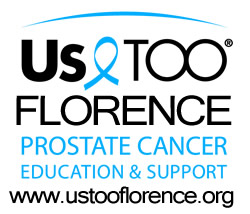|
||||||||
| Home | News You Can Use |
About Us TOO Florence |
Personal Journeys | Slideshows | Contact Us | |||
| Each man's Journey is listed under his BASIC treatment. When you click on one of the names to read a particular Journey, you may see one or more different treatments in bold lettering immediately above the Journey text. You will see (Recurrence) if they are due to a recurrence. Otherwise, they will be treatments used in conjunction with the basic treatment, i.e. Lupron with External Beam Radiation or External Beam Radiation with HDRT/Brachytherapy, etc. | |
Active Surveillance Alternative (Natural) Therapy Cryoablation - Freezing Hormone Therapy Radiation - Brachytherapy Radiation - External Beam Radiation - HDRT Surgery - Open Surgery - Robotic |
In 2005, a friend asked if I would attend a meeting regarding prostate cancer. I agreed, just to get information. I knew I was okay because I had no symptoms (not knowing anything about prostate cancer). At the first meeting of the prostate cancer support grout I attended, I met Dr. Bryan Mehlhaff of the Oregon Urology Institute. He asked when I had my most recent PSA test. He strongly recommended that I get a PSA test, and I did so as soon as possible. Dr. Mehlhaff phoned me with results of the first PSA 14. Shocked as I was, attending the support group meetings had already begun to provide enough information for me to stay reasonably calm. Following 30 days of antibiotics, another test on Aug. 13, 2005, produced a value of 12.7. A biopsy was in order. A 12-needle procedure in September 2005 indicated we had detected very early "symptom-less" prostate cancer. Of the 12 sites I had only two that were found to be positive, one with a Gleason Score of 6 (3+3); the second, showing a Gleason number of the "good" 7 (3+4). A "good" 7 means that it was less aggressive than a "not-so-good" 7 (4+3). Little things like that can make a big difference with prostate cancer. I met with Dr. Mehlhaff regarding treatment options. He referred me to Dr. Michael Bullock at Willamette Valley Cancer Center for discussions about radiation treatments. Dr. Bullock spent a great deal of time with my wife Marty and me describing treatments and answering our questions. Marty was interested in learning everything she could to support me on this journey. Dr. Bullock was optimistic about the outcome with radiation. I returned to Dr. Mehlhaff to review all my options, including several we had discussed in our prostate cancer support group. The group discussions include detailed personal descriptions of individual experiences of treatments, side effects, psychological impacts, importance of family support, how families are affected, etc. All of that collective experience is of tremendous value when making what is one of the most critical decisions of your life. I decided that I was going to undergo either surgery or radiation. Having stated that, I asked Dr. Mehlhaff, "What would you do, doctor?" Dr. Mehlhaff stated that since my involvement with prostate cancer was so minor, and the prognosis very positive, surgery was probably not necessary at my age (78 at that time). After a couple of days, I decided on external beam radiation followed by high dose radiotherapy (HDRT). External beam radiation consisted of going to Willamette Valley Cancer Center five days a week for five weeks. My transportation to Eugene was provided free of charge by the wonderful Friends of Florence. During my two HDR treatments, 19 small flexible needles were inserted through the perineum into my prostate gland and a high dose of radiation was delivered through each needle using a computer-guided radioactive iridium wire. After the sessions, the needles were removed from the prostate gland and my treatment was complete. This was in December 2005. Two days later I was driving our motor coach south for the winter. At no time during the treatments did I experience any serious discomfort. PSA tests? Aug. 12, 2005, it was 12.7 and by Sept. 7, 2010, it was less than 0.008 (undetectable). Even though my HDRT treatment was successful, would I make the same choice today? Possibly not. With the development of today's robotic assisted surgery, I would be sorely tempted to consider that for my treatment, saving radiation for a backup. Looking back on this journey, every professional with whom I interacted was extremely skilled and empathetic. They really do understand the patient's needs. I certainly will continue participating in the Us TOO Prostate Cancer Education/ Support Group. It is critical to keep up on the latest detection and treatment information, to participate in the exchange of personal experiences and to be there in support of others traveling this journey. Bob Horney provides excellent leadership for the group, and Dr. Mehlhaff and other professionals from Oregon Urology Institute, PeaceHealth and complementary therapies participate. As the name implies, education is an important component of the support group. The rest of my journey will be one of vigilance and regularly scheduled PSA tests. Fast forward now to Dec. 7, 2014: Clint fell while in Southern California, fracturing his left hip and requiring a partial hip replacement. During that process, a catheter was inserted; irritated the interior of the bladder and the bleeding began. Having returned home, he fell again on Jan. 22, 2015, fracturing his right hip. Life with the catheter continued and the bleeding got worse. Even though the bleeding started about nine years following the end of his radiation, it is highly likely that the radiation made his bladder susceptible to the bleeding which occurred. Clint and Dr. Bryan Mehlhaff tried several interventions to get the bleeding to stop, but nothing near a permanent solution was found and Clint ended up in the emergency room several times due to blood clots blocking urine from leaving the bladder through the catheter. Even cauterizing the area in the bladder was ruled out because Clint's body (he is now 88 years of age) wasn't getting enough oxygen to the bladder for it to heal underneath the scab from the cauterization. At this point, Dr. Mehlhaff recommended checking out the McKenzie Wound Center in Eugene which uses Hyperbaric Oxygen Therapy (HBOT) to help wounds heal. The McKenzie Willamette Medical Center in Springfield initiated the use of HBOT in 2009 upon opening its Advanced Wound Healing Center. It then opened the Eugene location at 3154 West 11th Ave. in January 2014 for the convenience of patients living in western Lane County. Both wound centers, under the direction of John Mackey, M.D., are fully equipped and staffed for HBOT. Clint's radiation cystitis met the criteria for treatment and he was initially signed up for a typical course of treatment five days per week for eight weeks, with each session lasting 2 hours. Dr. John Mackey shares the following information about HBOT: While red-blood cells are full of oxygen, the plasma that carries them through the body is relatively devoid of oxygen. During the treatments, the patient breathes 100 percent oxygen inside a pressurized chamber, quickly increasing the oxygen concentration in the blood plasma to complete saturation and increasing delivery of oxygen to damaged tissues by eight to 10 times. This saturation promotes the body's natural immune system and healing responses, allowing wounds to heal more easily, from the inside out. Those elevated oxygen levels promote optimum healing and stimulate formation of new microscopic blood vessels (capillaries) in damaged tissue. By comparison, the air we breathe is typically about 20 percent oxygen. The chambers are transparent so that patients can see and be seen and offer a TV/DVD and CD player along with phone communications for visitors to help patients feel at ease. Even though patients are under 2-3 times the normal air pressure of the atmosphere, the only pressure sensation one experiences is the need to "clear" the ears like going up a mountain or in an airplane. Clint's HBOT started on May 11, 2015. After four weeks, a sophisticated urine test was done and finding no trace of blood, he was declared healed and finished with treatments. Clint was told they have never had a patient return to the wound center after being treated for a bladder problem such as his. By breathing and circulating 100 percent oxygen throughout his entire body, he was also extending its healing properties to his two fractured hips. Although HBOT does not include hip fracture among its 13 approved specific conditions, this treatment is whole-body by nature and extends to any part of the body needing extra oxygen. Clint is now catheter free and uses only a cane when out-and-about. In spite of the recent significant advances in radiation technology, radiation cystitis remains between 1 and 2.5 percent. Anyone receiving radiation therapy 10 plus years ago, with less focused technology, was more likely subjected to bladder or bowel problems. The good news is, as Dr. Mackey states, HBOT can FIX that. |
| www.ustooflorence.org Copyright © 2010 - 2025 | |

